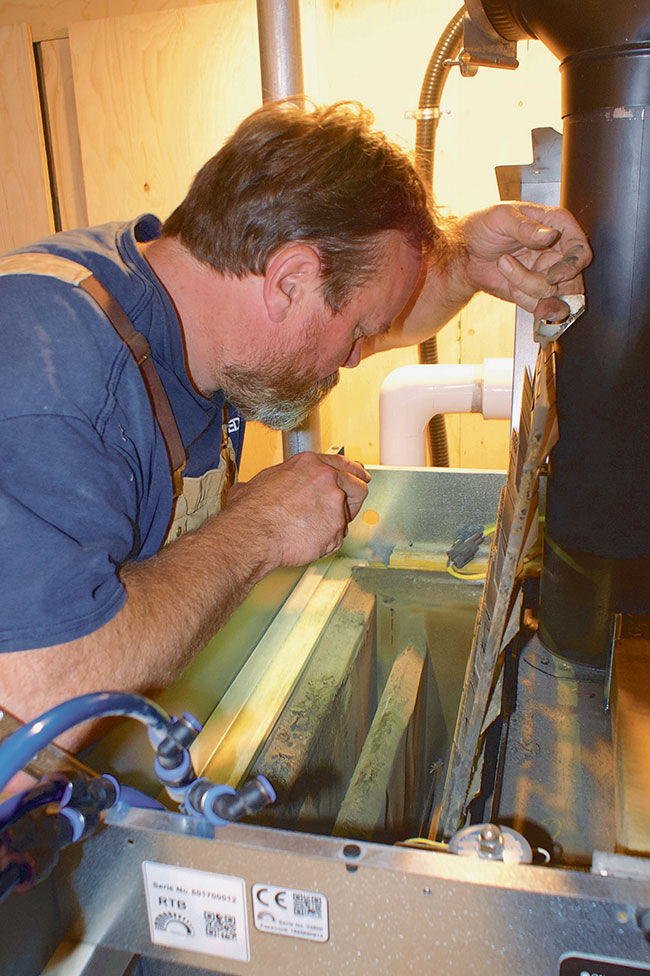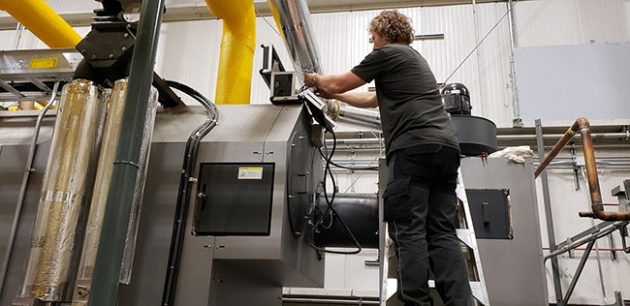
Boiler maintenance best practices
October 30, 2019
By
Ellen Cools
Industry experts share tips for properly maintaining biomass boilers
 THS Distribution’s Stephen Hayes examines a boiler with a flashlight. Photo courtesy THS Distribution.
THS Distribution’s Stephen Hayes examines a boiler with a flashlight. Photo courtesy THS Distribution.
Whether you run a large-scale industrial operation, a school, an office building or you’re a homeowner, if you’re using a biomass boiler, proper maintenance is critical. Canadian Biomass spoke to three biomass boiler experts to learn some of the best practices and tips for boiler maintenance.
Proactive maintenance
Our three experts – Fink Machine’s manager of business development David Dubois; THS Distribution’s owner and CEO Stephen Hayes; and Hurst Boiler’s director of marketing Jeff Hurst – all agree that proactive maintenance is the best practice when it comes to boiler maintenance.
“Most of the time the issue is that the boiler hasn’t been watched and it just gets dirty,” Hayes says. “I think that’s one of the hardest things for people to get used to. People think they can turn the heat on and walk away and not do anything about it.”
“The most successful operations have taken a look at all of the moving parts conveying fuel, water and ashes from their machine and realize the importance of well-trained operators, and a thorough proactive maintenance program,” Hurst adds.
A typical maintenance schedule varies based on the boiler make and model, and how much fuel it burns. Advancing technology has made it easier to monitor consumption and other factors. THS Distribution, for example, distributes boilers with an online component, allowing owners to monitor their performance.
Maintenance tasks
In general, maintenance can be broken down into daily, weekly, quarterly, and yearly checks.
On a daily basis, operators should do an overview of the boiler and look for any signs of obvious problems or dust that needs to be cleaned, Dubois says. Operators should also check if the fuel is within specification. Depending on how the fuel looks, a quick scrape of the fuel box while it’s running might be needed.
On a weekly basis, look to see if there are any light barriers, lenses or dust building up that needs a quick cleaning, Dubois advises.
Every three months or after burning 30 tonnes of fuel, Dubois says operators should shut down the boiler to do a deeper cleaning – clean various sensors, empty the ash, and check systems for signs of wear.
Over the life of a boiler, operators may need to change the fire brick inside the boiler because it is consumable. “Typically, it’s in the order of every five to 10 years, depending on what you’re using for fuel, how much contamination and how much they break down,” Dubois advises.
“On a yearly basis, if we assume it’s a spring shutdown, you’re going to want to run your fuel supply as empty as possible so you don’t have any fuel left in storage,” he adds. “Particularly with pellets, if you don’t have a super clean or super waterproof fuel storage for your pellets and you get even a little bit of water in there, left for a long time, it can actually turn the pellets into a solid mass similar to concrete that needs to be removed.”
Operators should also look at greasing bearings and any moving components. If the boiler has an air cleaning system, operators should do maintenance on the air compressor and check the air filters.
Hayes also recommends cleaning the chimney, plus removing and scraping the interior burner grate to make sure it’s clean.
“Check your ports, and then inspect the interior of the boiler, the burning chamber, with a flashlight to make sure there’s no build up,” he says. “Then you check the back of the boiler where the distribution chambers are, where you’ve got reflectors that slow down the movement of air so they absorb into the steel. If you remove those, you shake the grates off, check for any condensation or anything that’s not right with a flashlight down inside the chambers, and close it all up again.
“When I say check it with a flashlight, it is very important to make sure that there is no condensate inside your boiler, unless it’s made for it, because that’s what will destroy the interior of the boiler,” he emphasizes.
Once the boiler is ready to start back up operators should bleed any air out of the system, check for leaks, and make sure all sensors, fans, pumps and motors are operating correctly, DuBois says.
Plan ahead
When it comes to shutdowns, these should be planned, Hurst advises.
In an ideal situation, “the shutdowns have a diligently prepared set of separate tasks that use dedicated crews and contractors that are scheduled to avoid working at the same place at the same time,” Hurst explains. “These shutdowns are measured in hours, not days.”
Archiving equipment data files is important in order to know all of the particulars of your equipment. Hurst recommends keeping a list of each piece of equipment, keeping anticipated wear items on hand, and having a supplier and a back-up for all parts.
“Motors, belts, chains, Vari-hertz drive units, etc., – all of these could have local suppliers that will be glad to help out,” he elaborates. “Proprietary items that could be unique to just the manufacturer may need to be on the shelf as well.”
A parts inventory requires a substantial investment, but it’s better than finding out a necessary part is on backorder, he says.

Nathaneal Dyck, a technician with Fink Machine, tests the flue gas on a boiler. Photo courtesy Fink Machine.
Documentation
Dubois’ top tip for boiler maintenance is a good documentation program. Keeping track of any changes to the machine while going through maintenance checklists allows operators to see problems that might be developing.
“Sometimes these problems are slow to happen, but there are signs that something might be starting to go,” he elaborates. “If you’ve got this background for reference and documentation, that’s going to be key.”
“Diligent, legible log sheets should be a central part of the operator’s tasks,” Hurst adds. He recommends keeping an inspection checklist that determines how the operator’s time is used. “The operator should also be under continual development with a program of education and review, and there should be drills of what to do in case of certain scenarios.”
Additionally, keeping records and reports of outages and planned shutdown executions will be helpful in planning future shutdowns. Operators should keep a written plan for work to be done during outages and workarounds for work done while online, Hurst says.
Properly recording maintenance, scheduled downtimes and evaluating the machine’s performance is key to avoiding common failures. Hurst, Dubois and Hayes agree – failures are often easily avoided.
Fuel quality
The better the fuel quality, the less maintenance boilers require. This can mean the difference between doing maintenance once every three or four weeks versus once every three or four days, Dubois says.
“One of the big challenges that we see a lot of the time with clients is they get really focused on the price of their fuel, and they’ll try to get as cheap, low-rate fuel as possible that might not meet the required fuel specifications, and the result is that they end up doing way more maintenance on their boilers,” he says.
Hayes agrees, and has experienced first-hand the issues low-quality fuel creates. Typically, he checks his clients’ boilers when he delivers new fuel, three tonnes at a time. But once, when his supplier provided him a bad batch of pellets, he was cleaning out the boilers’ burners once every week. He suggests operators and homeowners make sure their fuel is coming from a reputable pellet or wood chip manufacturer.
One of the main causes of downtime, Hurst adds, is oversize, inappropriate fuel, which can be full of dirt and metal. For most large-scale operations, fuel is generated on-site, but “if supplied by a contractor, they will need to get rid of some ‘junk,’” Hurst explains. “Plan ahead for immediate rejection of out-of-spec fuel.”
The benefits of maintenance
There are other benefits to proper maintenance, too, which might not automatically come to mind.
Biomass boilers are often installed in remote locations far away from technicians who can service the machines. “So, properly maintaining your boilers and avoiding downtime is going to be critical, because it can be even worse by the time you factor in someone having to hop on a flight for two or three hours just to get there,” explains Dubois. It’s not just the cost of downtime and the cost of the service call – it’s also the cost of the travel.
While the initial workload may seem daunting, consistent and well-documented maintenance reduces the amount of maintenance necessary in the long run. The benefits far outweigh the costs.
This article is part of the Bioheat Week 2023. Read more articles about bioheat in Canada.
Print this page